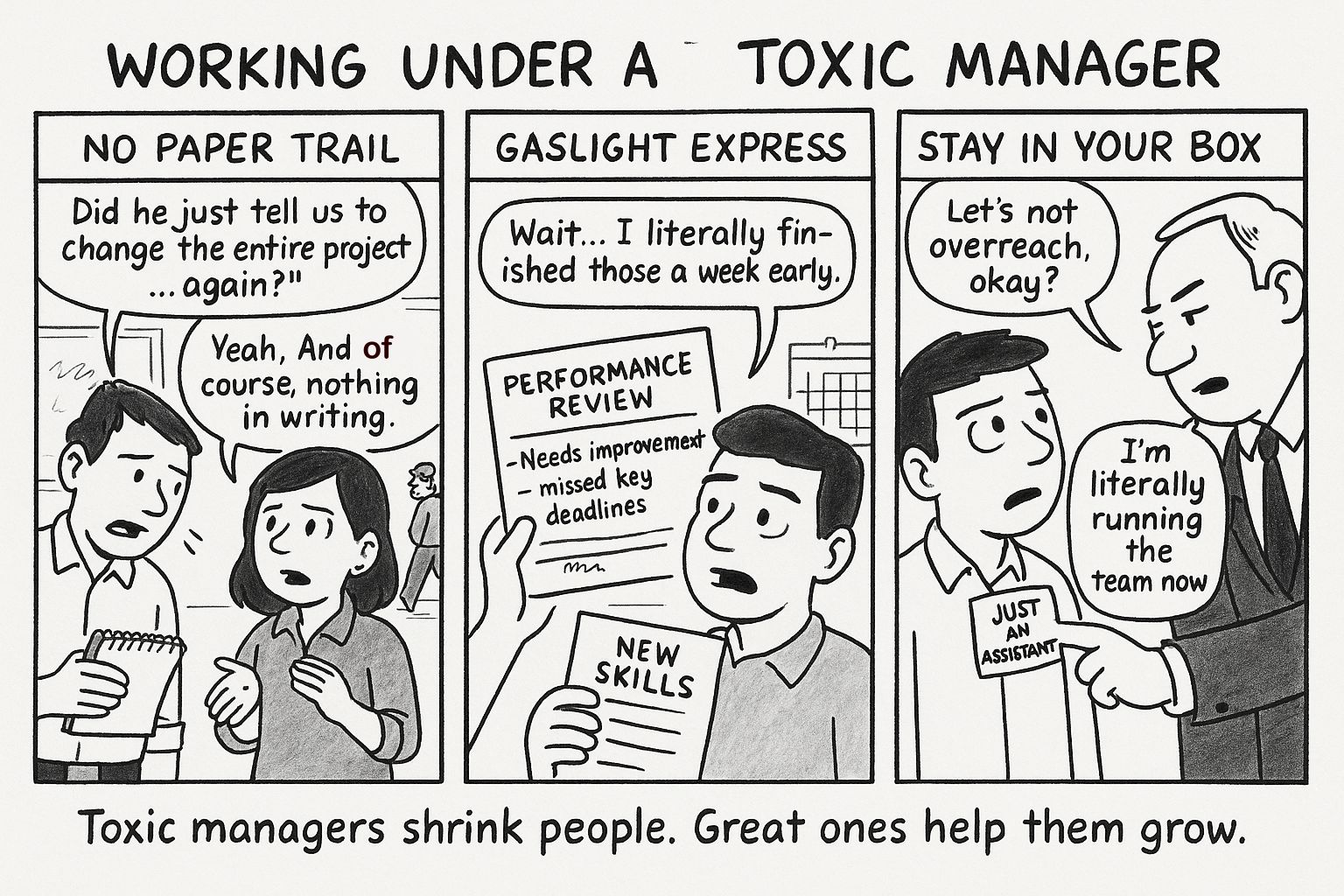Toxic managers are more common than we like to admit, and their subtle tactics can derail careers, damage morale, and reduce productivity across entire teams. Whether you’re early in your career or an experienced professional, knowing how to recognize and respond to toxic behaviors is a critical skill. Below are three common tactics toxic managers use and what you can do to protect yourself.

1. Avoiding Written Accountability
One hallmark of a toxic manager is a refusal to document conversations or decisions. They’ll deliver instructions verbally, avoid putting things in writing, and rely on ambiguity to shift blame later.
How this shows up:
You’re told something in a meeting, but there’s no follow-up email. They may delegate critical work without recording what was agreed upon, making it difficult to track commitments or expectations later.
How to protect yourself:
- Document everything. Send follow-up emails summarizing key points from conversations.
- Take and share meeting notes. Even if notes are sent by someone else, don’t hesitate to reply with your own additions or clarifications.
- Create a paper trail. If they don’t object to your version of events in writing, it often implies implicit consent.
Note: Some good managers also ask their teams to write things down, not to deflect accountability, but to empower autonomy. The difference lies in intention and transparency.
2. Gaslighting and Shifting Perceptions
Toxic managers are notorious for gaslighting, manipulating you into questioning your own memory or performance. This is especially common around performance reviews. Suddenly, perceptions change, feedback contradicts your progress, and you're left questioning reality.
How this shows up:
You’ve been hitting goals, but during review season, you’re told you’re not “collaborative enough” or “lacking initiative,” without clear evidence. Past mistakes are brought up, ignoring your recent improvements.
How to protect yourself:
- Track everything. Keep a daily log of your work and accomplishments.
- Reflect weekly. Summarize wins and challenges.
- Prepare receipts. Keep emails, performance data, meeting notes, and time-stamped records.
- Use tools. AI-powered note apps or RAG systems (Retrieval-Augmented Generation) can make this easier.
- Confront gently. If gaslighting occurs, calmly correct the record using documentation.
Rising stars or those undergoing personal or professional transformation are often more susceptible to these tactics because they threaten the status quo. Be especially vigilant if you’re in a period of high growth.
3. Defining You, Without Your Input
Toxic managers may try to dictate your strengths, your personality, or what your “lane” should be, limiting your growth to protect their own position.
How this shows up:
You’re repeatedly told you're “not technical,” “better at admin,” or “too ambitious,” even if your work shows otherwise. Your role becomes artificially narrow, with limited opportunities to stretch.
How to protect yourself:
- Seek outside mentorship. An external perspective is crucial. Find someone who will give you honest, constructive feedback.
- Track your own development. Keep a log of skills gained, challenges overcome, and projects completed.
- Share your progress. Monthly summary emails to key stakeholders can help set the record straight and reinforce your growth.
- Own your narrative. Don’t let one person define your identity or trajectory.
The Hidden Cost: Your Productivity
Working under a toxic manager is exhausting. It demands energy not just for your job, but also for managing optics, protecting your reputation, and navigating manipulation. That overhead is a silent productivity killer, not just for you, but for the entire team.
By contrast, great leaders reduce cognitive load. They create psychological safety, give credit, and empower you to focus on execution. That’s where real organizational performance is unlocked.
Final Thought: Create Space for Truth
One of the most powerful tools against toxic behavior is transparency. Implement regular team retrospectives and organizational health check-ins. When run well, these create safe spaces to discuss issues, clarify confusion, and dismantle toxic dynamics.
Toxicity thrives in silence. Honesty, structure, and reflection are your best defenses.